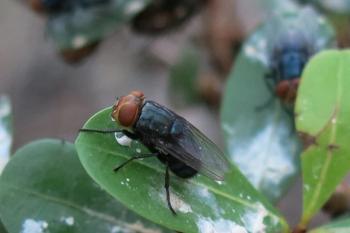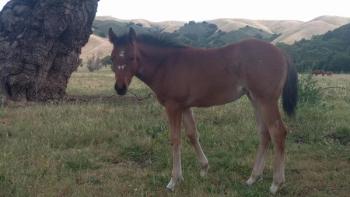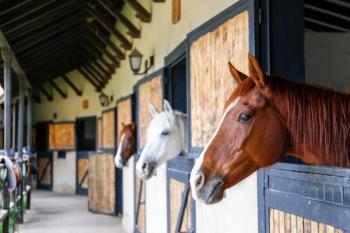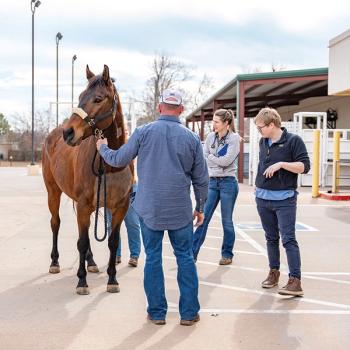
In search of the laminitic pathway
Early recognition is crucial to prevent the advancement of the disease.
Laminitis, a known debilitating disease of the foot, has been noted back to early history from Greek writings that cautioned against feeding horses too much barley, and Romans noted the condition following overuse of horses on stone roads. It continues to plague horses to this day.
This cut section of an equine foot depicts evidence of rotation and penetration of the tip of P3 through the sole.
Regardless of the origin of the initial insult, including gastrointestinal (GI), carbohydrate or grain overload, excessive early-spring grass intake, toxins from black walnut shavings, colitis, metritis, placental retention, at-risk Cushing's horse or from pounding the pavement, the end result is acute disease.
At one point, you have a normal healthy foot, then a trigger from a variety of origins, then laminitis and eventual lameness. In its most severe form, laminitis results in breakdown of the laminar attachment, separation and movement of the coffin bone as it rotates and descends within the hoof capsule, which can lead to a chronic or fatal prognosis. The disease begins with the initiation point and proceeds through a developmental stage prior to the acute phase of excessive laminar inflammation. Total destruction of the hoof structure can occur depending on the degree of inflammation and the extent of laminar tissue damage.
Laminitis cases by perceived cause
The two theoretical initial pathways are: The foot is affected by toxins or metabolites via its blood supply that damages the cells of the laminar tissue, or by what is thought to be a vascular origin promulgated by sustained decrease in blood flow through the laminar interface to a point where oxygen delivery to the foot falls below the level needed for normal metabolic function. Various mechanisms have been hypothesized to cause reduction of blood flow through the foot.
The final common pathway is thought to be one of mediation of extreme inflammation within the hoof capsule that eventually severely damages the laminar tissue leading to detachment of the coffin bone. But whether inflammation or possibly ischemia, the final common pathway is still unidentified at this time, according to David Hood, DVM, PhD, Texas A&M University. It would be of interest to know how the triggers promote the inflammatory mediators and how the disease can be prevented.
Why? Theoretical response
Countless ponies, pleasure horses and other performances horses have been affected by laminitis. Why do some get it? Why do some survive? The complete picture isn't clear.
"You're limited in what you can do to treat the initial cause because we don't have a clue of what triggers this thing," says Ric Redden, DVM, farrier, International Equine Podiatry Center in Versailles, Ky. "We have a lot things that are primary that will precipitate the syndrome, but we don't know the linkage of how they do it."
Presently, the best tactic is to try to recognize the disease as early as possible and prevent it from advancing, says James Orsini, DVM, University of Pennsylvania.
"We know during the developmental phase of the disease we can prevent the progression to the acute phase by using an old technique of icing the feet; standing the horse in a cold stream," Orsini says. "The other important goal is to identify risk factors. We can then identify the at-risk patient and spend more time monitoring for the disease or even better, prophylactically icing the feet and more aggressively using anti-inflammatories to prevent the disease from progressing to the acute stage and then the chronic phase."
The chronic stage is the most devastating because once rotation begins, the foot is unstable, and a more difficult clinical situation arises relative to day-to-day care and expense, frequently ending in humane destruction.
One question that still must be answered, says James Belknap, DVM, PhD, The Ohio State University, is with all the different kinds of laminitis, do they all follow the same pathway? In each case it looks the same as in human sepsis, what human physicians call systemic inflammatory response. Whether it's initiated by colitis, metritis, a grain overload or a post-colon torsion surgery, the horses usually have brick-red membranes, high heart rate and thready pulse. Virtually everything human physicians look at is a systemic inflammatory response. What is being studied in horses is what role does the leukocyte play? What they found in human organ failure is that sepsis is mainly due to leukocyte infiltration into the organs, expressing ROS (reactive oxygen species — free radicals). Where they used to think it was just ischemia, they're finding now it's really not ischemia as much as it is damage to the mitochondria, and then the cells can't function correctly. Belknap and colleagues then did a corollary study in horses.
Using the black walnut laminitis model, a marked infiltration of leukocytes into the laminae during the developmental stage of the disease was found.
"Interestingly, if you look at those horses at that stage, their feet are normal. They're not lame; they do not have a bounding pulse, but they already have an incredible increase in inflammatory cytokine expression," Belknap explains. "Along with cytokines, there is an incredible neutrophil emigration from the blood vessels into the laminae, very similar to human sepsis. What we are finding with most of these laminitis cases, whether it's a colitis case or carbo-hydrate overload from lush grass, you're ending up with a GI disruption and absorption of bacterial toxins, leading to systemic inflammation and leukocyte emigration out of the blood vessels into these tissues. As black walnut toxicity has a much more rapid onset, it is likely that a toxin from the heartwood is absorbed, which leads directly to systemic inflammation. I think it's very likely that the laminar failure that follows is similar to what they're finding in human organ failure in sepsis. Previously, organ failure in human sepsis was thought to be due to low blood flow, ischemia. They found otherwise. It's just that the cells can't use the oxygen because they have such a high load of ROS and inflammatory cytokines that lead to damage to the mitochondria. In equine medicine, we're just getting there right now."
Recently, Belknap has found that the same leukocyte infiltration occurs simultaneously in the skin, which he suggests is further evidence that the inflammatory changes seen are not due to an isolated ischemic episode in the foot.
Counterpoint
But some researchers do notice circulation problems in the early stages of the disease.
"Using multiple forms of laminitis, we know positively that there is a decrease in blood flow to the foot during the developmental stage(s) before lameness," Hood says. "At the occurrence of lameness, it is increasing. Just after the occurrence of lameness, blood flow gets abnormally high. Just because there is a decrease in blood flow during the developmental stage doesn't mean that there is ischemia.
"In a study in horses where blood flow to the foot was occluded for a short period of time, the same lesions that you see in clinical laminitis were created. Histologically, the same pattern is seen as blood flow is shut off and allowed to flow to the foot again. Mild foot pain accompanied the model. This suggests that there is an ischemic change creating the lesions that we're seeing in the laminar interface," Hood suggests. "It may be absolutely correct that it is not ischemia, as Belknap suggests, though we don't know that yet. I'm not saying he's wrong, but that's the question until it is proven. The inflammation may cause changes in blood flow, and changes in blood flow may cause inflammation. According to our data, you can establish a theoretical link to ischemia. Road founder, septic shock, patients with colitis, retained placentas, carbohydrate overload, fluid imbalance, etc., with all these divergent causes, you can show that ischemia is there."
Once you've reached the acute phase of laminitis, you have a massive amount of inflammation with the presence of the various mediators, including leukotrienes, cytokines, prostaglandin, Interleukin-B1, protein-C, NfkappaB, etc. These mediators are appearing before the horse becomes lame, and so is the decreased blood flow. Which one comes first has not been determined.
Treatment options
Certainly with any horse at risk, because of the phenomenal inflammation, treatment includes the aggressive use of non-steroidal anti-inflammatories (NSAID).
"We've found an incredible amount of cytokine expression (up to 1,000-fold increase) COX-2, as well as numerous other cytokines, Belknap says.
As a treatment option, drugs that decrease leukocyte activation are being looked at; so is the use of more aggressive doses of NSAIDs.
"What am I going to do with a horse with early signs, whether one with metritis or colitis, or post-op colon torsion? I'm going to do the physical things of padding its feet, and then give it a very aggressive regimen of NSAIDs," Belknap says.
"One thing that they've shown on the human side, which I'm sure is true for us too, is that when you use high doses of NSAIDs, you actually block more than just COX-2. You also seem to block some of the other inflammatory cascades at a more basic level, such as NF Kappa B," Belknap continues. "NF Kappa B is a basic protein that induces all the inflammatory cascades. These horses have phenomenal inflammation, even though they're showing absolutely no clinical signs. They may have normal feeling feet, have no digital pulse, and they're not lame. So I think the biggest thing we've got to really nail down is that there is incredible inflammation going on early, both systemically and locally. If we hit that hard, as they are doing in human sepsis, I think we may make a difference here, too."
They're focusing on some other products as well, such as the metallo-protease inhibitors.
"If you can block the systemic leukocyte activation, maybe we don't have to worry about it, though I don't think there is going to be a silver bullet," Belknap says.
Is it manageable?
Treatment options haven't made much progress in the past 30 years, says Bill Moyer, DVM, director of Large Animal Medicine at Texas A&M University College of Veterinary Medicine.
"The basic problem is that there is a lag time between the trigger point and when pain occurs," Moyer explains.
There typically is a certain amount of damage within the interface of the coffin bone and the hoof capsule before it's painful. It might have started 72 hours ago, and yet the horse is not lame. Then there is an additional lag time, which sometimes is more extraordinary then the first, when it starts to bother the horse and when an owner or a horseman is even aware of it.
"By the time the veterinarian is asked to examine the horse, it is not at all unlike calling the fire department after the barn is already razed," Moyer says. "The problem in trying to manage them is that we're already too late by the time we get there. Let's assume we're on time. What are we going to do about it? How are we going to stop it? Even the medications that we've classically used for years don't seem to make a difference to the outcome. Down the line, we've got to figure out how to prevent it. That's the solution. By the time you treat it, you're already dealing with a forest fire with just a balloon full of water. What I attempt to do is to try to manage each foot as best I can. It's seldom I'm doing the same thing even to each foot, much less on each horse," Moyer says.
The venogram
Redden has been treating the clinical stage for 30 years and says that there has been tremendous progress made in how we can monitor the case, fully assess it and precisely know its status.
"With laminitis, we have a way of evaluating the signs, the symptoms and the clinical workup. If you don't have a way of assessing the amount of damage that has occurred at any particular stage of the syndrome, then your chances of treating the disease are left purely to chance," he says.
Redden developed the clinical protocol for the venogram in 1992; he's done more than 3,000 venograms since then.
The venogram is indicated because it allows you to clearly assess the value of the circulatory system of each foot or each part of the foot at any stage of the syndrome.
"You have to interpret what you see, and that's where the real kicker comes in the interpretation," Redden remarks.
Using the venogram, you can assess how far a horse is from stable. Compared to a normal venogram, the horse can be assessed to be so far from stable, compared to the normal soft-tissue para-meters.
"I don't like to use the word 'stable' in assessing my cases because when a horse appears to be clinically improved, it means nothing unless your venogram shows he's clinically improved and your soft-tissue parameters show he's clinically improved, which means he's growing sole, about 1 to 2mm every three to four days," Redden says. "If he's doing that, his venogram will show you why he's doing that because his fimbriae are becoming functional again."
The future
Practitioners expect the next few years to be very exciting, and the progress will be much faster, Belknap says.
"Our best chance is to find drugs that are going to knock this out in the beginning before you get the secondary breakdown of the laminae, the collagen, the basement membranes, etc."
Hood says he expects the profession to identify the pathway during the next four to five years, ultimately facilitating the work toward a cure.
"Rehabilitation is where we're really making an impact," Hood says.
Currently there is research going on where veterinarians are going to see a major improvement in getting these horses back to function. The prognosis and the long-term outcome of chronically affected horses is where most of the improvements are really going to impact the disease. Usually by the time most of the laminitic horses are brought to the attention of a veterinarian, or maybe before a horse is diagnosed, it is already in the early chronic phase.
But appropriate clinical management of the acutely affected horse has significantly reduced the incidence of progression on to chronic laminitis. Research on the chronic laminitic horse has significantly increased the number of horses with chronic laminitis that can be successfully rehabilitated.
Newsletter
From exam room tips to practice management insights, get trusted veterinary news delivered straight to your inbox—subscribe to dvm360.






